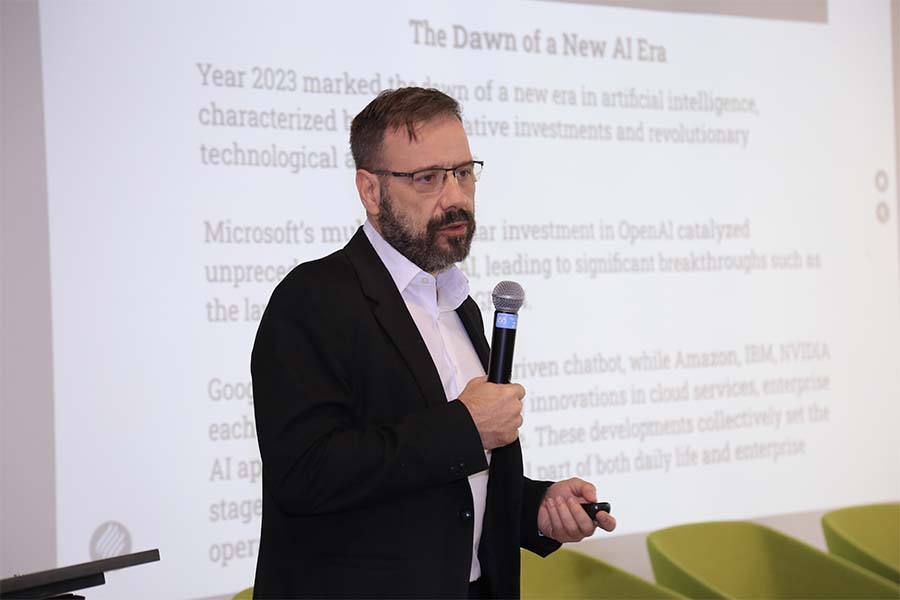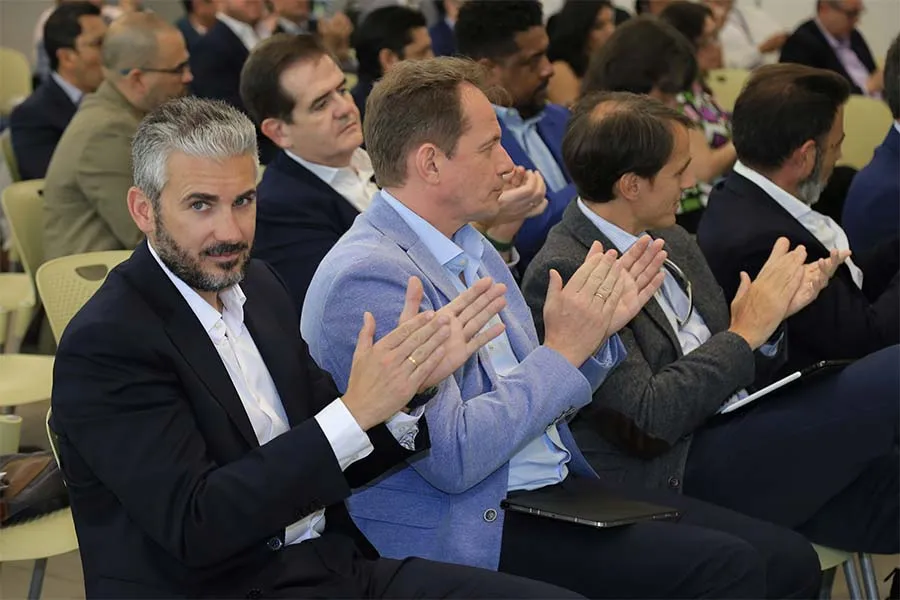What has happened in the world since the advent of artificial intelligence (AI)? What progress has been made in 2024 and what is expected for 2025? These are the questions answered by Carles Abarca, Tec de Monterrey’s Vice President of Digital Transformation, at the first ISMS International Cybersecurity Forum in Mexico.
“This year (2024), AI will leave the text realm and acquire human capabilities, mastering speech, sight, and hearing. I dare say that there will already be AI-generated film production by 2025, or year 3 of AI.”
Additionally, he gave an overview of year 1 (2023) of the AI era, what is expected in 2024, and what we will possibly see in 2025, according to the evolution of this technology.
He also talked about the cybersecurity challenges that this era brings.

Year 1 of the artificial intelligence era: Explosion
The Tec’s Vice President of Digital Transformation named 2023 year 1 of this new era of artificial intelligence (AI) because, as he says, it was filled with events, news, announcements, and never-before-seen figures on artificial intelligence.
He sums up the highlights of year 1 as:
- Microsoft makes a multi-billion-dollar investment in OpenAl to launch ChatGPT-4.
- Google presents Bard, an artificial intelligence-powered chatbot.
- Amazon, IBM, and NVIDIA introduce innovations in cloud services, Al business applications, and Al hardware.
In terms of Technology, Carles Abarca stated that year 1 can be summarized as:
- Generative AI revolutionizes interactions with technology, improving efficiency and accuracy in a variety of applications.
- In cybersecurity, AI enhances threat detection and response capabilities, significantly reducing the risk of cyberattacks.
- In IT infrastructure, Al-driven optimization and automation improve performance and reduce operating costs.
The Tec de Monterrey executive summarized the explosion of AI with the following figures:
- There was a global investment of 500 billion dollars in AI.
- More than 60% of the world’s top companies (e.g., Amazon, Apple, and Walmart) already use AI in some aspect.
- Additionally, more than 20 million jobs were created in AI-related fields.
According to Carles Abarca, these developments set the stage for artificial intelligence to become an integral part of our daily lives and business operations.
{"preview_thumbnail":"/sites/default/files/styles/video_embed_wysiwyg_preview/public/video_thumbnails/nXVvvRhiGjI.jpg.webp?itok=AlZJaE-x","video_url":"https://youtu.be/nXVvvRhiGjI?si=ki8xK45bAYqGbjAH","settings":{"responsive":1,"width":"854","height":"480","autoplay":0},"settings_summary":["Embedded Video (Adaptable)."]}
Year 2 of the artificial intelligence era: Integration
Abarca describes 2024 as the year of “innovative integrations” of artificial intelligence. He summarizes them as:
- Improved search functionalities, such as the evolution of Google’s Gemini Al model.
- Microsoft’s greater collaboration with NVIDIA to accelerate the deployment of AI across business and the introduction of powerful new AI tools, such as Veo for video generation.
“Collectively, these advances are pushing the limits of what artificial intelligence can achieve. This year (2024), AI will leave the text realm and acquire human capabilities, mastering speech, sight, and hearing,” said Carles Abarca.
He also mentioned Google’s Project Astra as an example. This is an assistant that uses human capabilities such as sight, speech, and hearing to provide real-time responses.
“This year, AI will leave the text realm and acquire human capabilities, mastering speech, sight, and hearing.” – Carles Abarca
The challenges of AI cybersecurity
“While this technology has improved threat detection and response, predictive analytics and threat intelligence, and automation and machine learning, there are new challenges in cybersecurity.”
Carles suggested paying special attention to 3 points in artificial intelligence cybersecurity:
1. Robust security frameworks for Al Systems
“Developing and implementing comprehensive security frameworks designed specifically for Al systems is crucial. And these should include regular security audits, vulnerability assessments, and updates to address new threats.”
2. Defense against adversarial attacks
AI systems must be trained to recognize and defend against adversarial attacks such as malicious data designed to fool AI models.
“For example, we need to train AI with the technique of adversarial training, so that it can improve the resilience of AI systems.”
3. Securing the Al supply chain
Ensuring the security of the entire AI supply chain from data collection and model training to implementation is essential.
This includes using secure data sources, protecting the integrity of training data, and ensuring secure deployment environments.

About the first ISMS International Cybersecurity Forum in Mexico
This first edition in Mexico was organized by ISMS Forum in collaboration with Tecnológico de Monterrey’s Mexico City campus.
ISMS Forum is a non-profit organization founded in January 2007 to promote the development, knowledge, and culture of information security in Spain.
Since 2019, it has held several international events, with issues related to cybersecurity and data protection being discussed at each venue.
There are currently seven chapters of this Forum: Barcelona, Valencia, Galicia, Euskadi, Andalusia, Portugal, and Mexico joining this year.
“I dare say that by 2025, or year 3 of AI, there will already be AI-generated film production.” – Carles Abarca
According to Alberto Hernández, information security officer at Santander Mexico and Board Member of ISMS Forum:
“This forum was born from the need to work together, collaborate, and establish dialogue with our colleagues in Mexico and Spain. Additionally, the increase in cybersecurity attacks internationally has made this urgent.”
“I’m confident that if we leverage our capabilities, working collaboratively, we will find more solutions.”
YOU’LL ALSO WANT TO READ:






